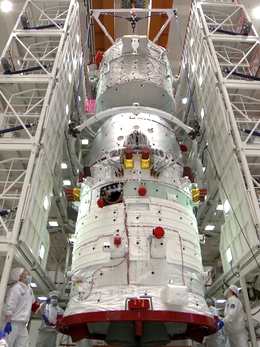
Back Shenzhou Afrikaans Shenzhou (nau espacial) AN شنتشو (مركبة فضائية) Arabic Шънджоу Bulgarian শেনচৌ (মহাকাশযান) Bengali/Bangla Šen-čou Czech Shenzhou German Σένζου (διαστημόπλοια) Greek Shenzhou (kosmoŝipo) Esperanto Shenzhou Spanish
 A Shenzhou spacecraft undergoing ground testing without solar panels | |
| Manufacturer | CAST |
|---|---|
| Country of origin | |
| Operator | CMSA |
| Applications | Crewed spaceflight |
| Specifications | |
| Launch mass | 8100 kg[1] |
| Crew capacity | 3 |
| Dimensions | 9.25 x 2.8 m |
| Volume | 14.8 m3[1] habitable: 7.0 m3 |
| Regime | Low Earth |
| Design life | Up to 183 days (docked at the Tiangong space station) |
| Production | |
| Status | In service |
| On order | 1 |
| Built | 18 |
| Launched | 18 |
| Operational | 1 |
| Failed | 0 |
| Maiden launch | Shenzhou 1: 19 November 1999 (uncrewed) Shenzhou 5: 15 October 2003 (crewed) |
| Last launch | Active Shenzhou 18: 25 April 2024 (crewed) |
Shenzhou (Chinese: 神舟; pinyin: Shénzhōu, /ˈʃɛnˈdʒoʊ/;[2] see § Etymology) is a spacecraft developed and operated by China to support its crewed spaceflight program, China Manned Space Program. Its design resembles the Russian Soyuz spacecraft, but it is larger in size. The first launch was on 19 November 1999 and the first crewed launch was on 15 October 2003. In March 2005, an asteroid was named 8256 Shenzhou in honour of the spacecraft.
The Shenzhou spacecraft is slated to be replaced in the late 2020s by a next-generation crewed spacecraft named Mengzhou, currently under development. The new spacecraft has a configuration more similar to the Apollo program's command and service module, which is different from the configuration of the Shenzhou spacecraft.[3]
- ^ a b 朱光辰 (2022). "我国载人航天器总体构型技术发展". 航天器工程. 第31卷 (第6期): 47.
- ^ "Shenzhou pronunciation". Dictionary.com. Retrieved 25 April 2015.
- ^ Zhao, Lei (24 February 2024). "Chinese lunar lander and new crew spaceship names revealed". China Daily. Retrieved 4 March 2024.
© MMXXIII Rich X Search. We shall prevail. All rights reserved. Rich X Search